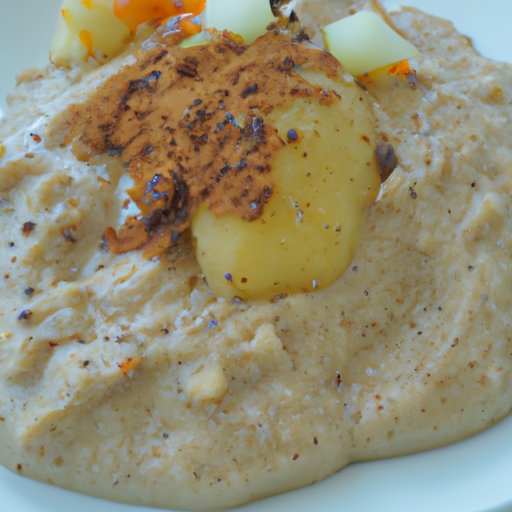Introduction
A soft diet is designed to make eating easier for those with digestive issues or dental problems. This type of diet focuses on softer foods that require minimal chewing. It’s important to understand what types of food are appropriate for a soft diet, as well as how to create meal plans and recipes that follow these guidelines. In this article, we’ll explore the basics of a soft diet and provide tips and tricks for making the most of it.
Soft Foods for Easier Eating: Understanding a Soft Diet
A soft diet is made up of foods that are easy to chew and swallow. This includes soft proteins like eggs, tofu, fish, poultry, and cooked legumes. Soft fruits and vegetables such as applesauce, mashed potatoes, cooked carrots, bananas, and zucchini are also allowed. Dairy products such as yogurt and cottage cheese are usually included in a soft diet, as well as whole grains like cooked oatmeal, quinoa, and rice.
Foods to avoid on a soft diet include raw vegetables and fruits, nuts and seeds, popcorn, chips, and crunchy granola bars. Chewy meats like steak and pork should be avoided, as well as tough breads and crackers. Additionally, any food that requires more than minimal chewing should be avoided.

A Guide to Soft Diets for Those With Sensitive Digestive Systems
Soft diets can be beneficial for those with sensitive digestive systems, such as those suffering from irritable bowel syndrome (IBS). According to research published in the journal Gastroenterology Research and Practice, “a soft diet is recommended to reduce symptoms of pain, bloating, and discomfort caused by IBS.” The study found that a soft diet can help reduce inflammation in the gut and improve digestion.
For those following a soft diet, there are a few tips to keep in mind. First, it’s important to drink plenty of fluids throughout the day to help keep the digestive system running smoothly. Additionally, it’s important to eat small, frequent meals throughout the day to ensure proper nutrition and energy levels. Finally, adding probiotics to the diet can help promote healthy gut bacteria and support digestion.
Soft Diet Basics: What You Need to Know
When following a soft diet, there are certain guidelines to keep in mind. Soft foods should be cut into small pieces and chewed thoroughly before swallowing. Additionally, foods should be cooked until they are soft and easily mashed with a fork. Cream-based sauces and gravies are generally allowed, but should be used sparingly as they can be difficult to digest.
Foods that should be included in a soft diet include cooked eggs, tofu, fish, poultry, cooked legumes, cooked vegetables, soft fruits, dairy products, and cooked grains. Avoiding raw vegetables and fruits, nuts and seeds, popcorn, chips, and crunchy granola bars is recommended. Additionally, chewy meats, tough breads, and crackers should be avoided.

Soft Diet Recipes for Easy Digestion
There are many delicious recipes that are suitable for a soft diet. For breakfast, oatmeal with banana slices and honey is a great option. For lunch or dinner, try a soft quinoa salad with steamed vegetables and a light vinaigrette. Snacks can include yogurt with fresh fruit or a smoothie made with almond milk and frozen berries.
Making the Most of a Soft Diet: Tips & Tricks
Eating a soft diet doesn’t have to be boring or restrictive. There are many ways to make meals more interesting, such as trying different spices and herbs, experimenting with different cooking methods, and using substitutions for harder-to-digest ingredients. For example, instead of using regular wheat pasta, try using quinoa pasta or zucchini noodles.
Meal planning can also be helpful when following a soft diet. Planning out meals for the week ahead of time can help save time and ensure that all meals are nutritious and easy to digest. Additionally, prepping meals ahead of time can make mealtime easier during busy weeks.

Benefits of a Soft Diet: Why Some Prefer It
A soft diet can offer many benefits, such as improved digestion and increased comfort. According to a study published in the journal Nutrients, “a soft diet may provide relief from abdominal discomfort and bloating associated with IBS.” Additionally, the study found that a soft diet can provide essential nutrients while still being gentle on the digestive system.
In addition to providing digestive benefits, a soft diet can also be beneficial for those with dental problems or difficulty chewing due to age or illness. Eating soft foods can make mealtime easier and more enjoyable while still providing essential nutrients.
Conclusion
A soft diet can be beneficial for those with digestive issues or dental problems. It’s important to understand what types of food are appropriate for a soft diet and how to create meal plans and recipes that follow these guidelines. Additionally, it’s important to remember to drink plenty of fluids, eat small, frequent meals, and add probiotics to the diet to promote healthy gut bacteria and support digestion. By following these tips and tricks, it’s possible to make the most of a soft diet and enjoy nutritious meals that are easy to digest.
(Note: Is this article not meeting your expectations? Do you have knowledge or insights to share? Unlock new opportunities and expand your reach by joining our authors team. Click Registration to join us and share your expertise with our readers.)
